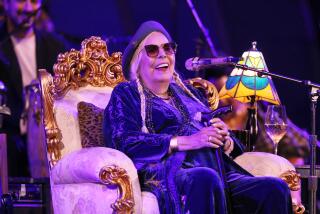The L.A. Open : His First Full Tour : Mickelson Had an Exceptional Amateur Career; Now He’s Making His Mark as a Professional
- Share via
Expectations for Phil Mickelson have always been as high as a wedge shot to a green--and justifiably so.
Seldom has an amateur turned professional with as many credentials as Mickelson brought to the PGA Tour.
--He was the junior player of the year when he was 15, 16 and 17.
--He is the only left-handed player to win the U.S. Amateur (1990) and the only player other than Jack Nicklaus to win that event and the NCAA championship in the same year.
--He was only 20 years old and a junior at Arizona State when he won the Tucson Open in 1991.
--He was the first amateur to win a tour event since Scott Verplank won the Western Open in 1985.
--He made an auspicious pro debut in the first round of the 1992 U.S. Open at Pebble Beach when he shot a 68, only to falter with an 81 the next day and miss the cut.
Later in the season, Mickelson finished second in the New England Classic after failing to qualify for the British Open.
Now, at 22, he’s in his first full season as a pro, and he will be evaluated on what he does on the tour. So far, so good. Mickelson won the Buick Invitational of California Sunday in his hometown of San Diego by shooting a final round of 65 for his first victory as a pro. He had eight birdies and won by four shots over Dave Rummells, the third-round leader.
“If he stays healthy, he’ll win many, many tournaments and many, many majors,” television golf analyst Johnny Miller said of Mickelson.
There is, of course, always the specter of Verplank, who has faded into obscurity after his only tour victory as a pro in 1988.
But Mickelson is poised for his age, and there’s a quiet self assurance--not bravado--in his manner.
Asked if he has any specific goals, Mickelson said:
“My goals are kind of personal, but (one) thing I’d like to work on is to be a little more consistent off the tee, so I don’t put myself in a bind right away.
“I (also) need to be more consistent putting because it doesn’t matter how well you’re hitting the ball. If you’re not capitalizing on your opportunities, you’re not going to shoot a low score. “If I can accomplish those things, I think the results will come.”
He said his only previous appearance in the L.A. Open was in 1988 when he was a teen-ager and missed the cut.
“There’s a lot of history there (Riviera). I’m looking forward to it,” Mickelson said. “I thought it was pretty difficult when I played there. You really had to play well, and I can’t believe how low the scores have been over the last few years.”
Mickelson is still making the adjustment of playing four rounds in a tour event, rather than the three he played as a collegian.
“That may be the most difficult thing because out on tour playing one or two good rounds isn’t enough,” he said. “If you played one or two decent rounds in college, you had a shot at winning the tournament. But here if you play one or two good rounds, it doesn’t mean anything. You need to play three good rounds before you can even think about winning. It takes a lot more patience.”
Mickelson is playing in more tournaments than he did in college, but the adjustment has been favorable for him.
“I don’t have school to contend with now,” he said. “Previously, I had classes in in the morning, practice in the afternoon and homework at night. In my last year and a half of school, there were also a lot of outside interests, such as finding an agent, responding to letters or photograph requests,” he said.
He now has help for those details. “A lot of burdens have been taken off my shoulders.
“The most difficult thing is traveling to cities I’ve never been to and playing courses I’ve never played.”
Even though Mickelson is a newcomer on the tour, he has a commercial status of more proven veterans.
He is a playing editor of Golf Digest, the world’s largest monthly golf magazine. He also represents club and golf ball manufacturers and a clothing line, along with other endorsements. So he’s commercially successful.
Mickelson hasn’t patterned his game after any one player, but there are certain aspects he admires, such as:
“I like the way Ben Crenshaw rolls the ball. He’s such a great putter. There’s Seve Ballesteros’ imagination, Jack Nicklaus’ mental toughness and preparation, Greg Norman’s length and Nick Faldo’s patience.”
Perhaps, someday, another young player will be admiring a particular skill of Mickelson’s.
More to Read
Go beyond the scoreboard
Get the latest on L.A.'s teams in the daily Sports Report newsletter.
You may occasionally receive promotional content from the Los Angeles Times.









